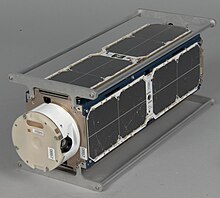This article relies largely or entirely on a single source .(December 2015) |
| Mission type | Earth imaging |
|---|---|
| Operator | Planet Labs |
| Website | www |
| Spacecraft properties | |
| Spacecraft type | CubeSat |
| Bus | Dove |
| Launch mass | 5 kg (11 lb) |
| Dimensions | 10 cm × 10 cm × 30 cm (3.9 in × 3.9 in × 11.8 in) (3U) |
| Power | 20 watts |
| Orbital parameters | |
| Reference system | Geocentric orbit |
| Regime | Low Earth orbit |
| Inclination | 51.66° |
Flock-1 is a CubeSat satellite constellation launched on 9 January 2014. The satellite is built in a CubeSat bus, and each constellation consists of 28 satellites. All instruments are powered by solar cells mounted on the spacecraft body, along with triple-folded wings, providing approximately 20 watts at maximal power.
